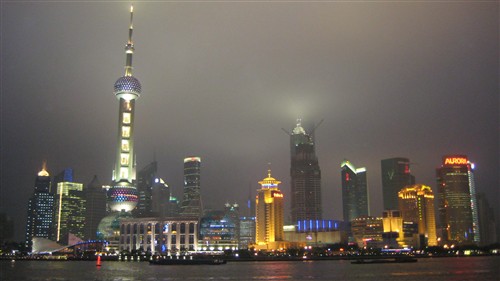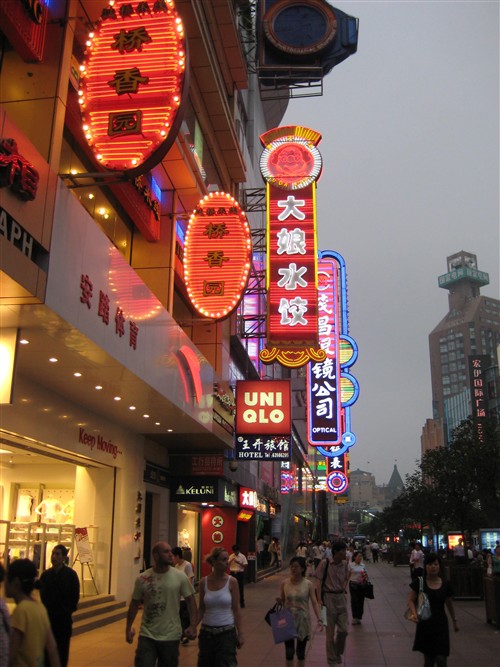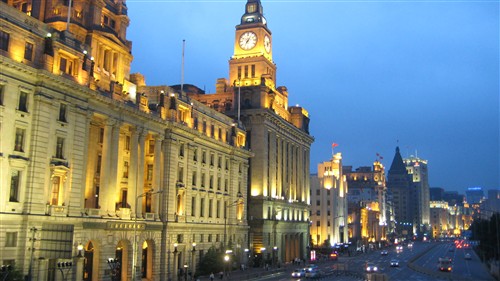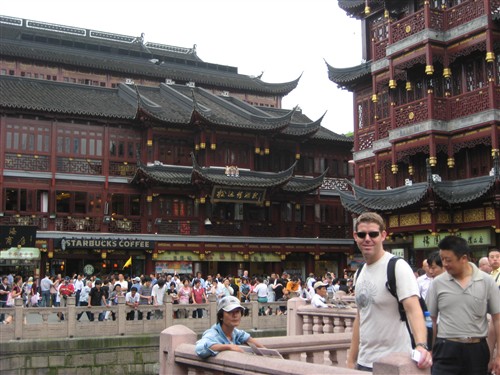Posted under China

In Shanghai, we have been trying to give China the benefit of the doubt. Shanghai City Central Youth Hostel turned out to be one of the best that we’ve seen on the road and we stayed indoors the entire first day, recovering from the Yangzi River debacle.
On our second morning, we woke refreshed and ready to explore. Taking the metro to the People’s Square in the city center, we walked leisurely through the park toward the Shanghai Museum, which had been highly recommended in our guide book. A large fountain decorated the courtyard in front of the museum, which was crowded with locals playing in the spray, selling kites and souvenirs, and just enjoying the day. The entrance was around the back and when we made our way there, we found a line of at least two hundred people waiting for the museum. This was at lunchtime on a weekday. We grumbled about the overpopulation in China and decided to move on.
 We headed down East Nanjing Road on a wide pedestrian walkway lined with several stories of restaurants, retail shops, billboards and flashy neon signs with Chinese characters. The walkway was crowded with walkers and we were almost incessantly pestered by people peddling cheap watches, jewelry, handbags, leather goods and electronics. None of them spoke more than a few words of English but they were all quite assured that they had what we wanted, whatever it might be. They all had identical laminated picture cards showing an array of tacky accessories. The street itself was a spectacle, both fascinating and dizzying, with bright lights and people everywhere. We walked the length of it to the Bund, a famous street in Shanghai where a grand façade of Old European buildings face the modern architecture of the Pudong skyline across the Huangpu River. An elevated promenade along the west bank of the river was bustling with tourists and locals alike, taking in Shanghai’s best views.
We headed down East Nanjing Road on a wide pedestrian walkway lined with several stories of restaurants, retail shops, billboards and flashy neon signs with Chinese characters. The walkway was crowded with walkers and we were almost incessantly pestered by people peddling cheap watches, jewelry, handbags, leather goods and electronics. None of them spoke more than a few words of English but they were all quite assured that they had what we wanted, whatever it might be. They all had identical laminated picture cards showing an array of tacky accessories. The street itself was a spectacle, both fascinating and dizzying, with bright lights and people everywhere. We walked the length of it to the Bund, a famous street in Shanghai where a grand façade of Old European buildings face the modern architecture of the Pudong skyline across the Huangpu River. An elevated promenade along the west bank of the river was bustling with tourists and locals alike, taking in Shanghai’s best views.
As the gateway to the Yangzi River, Shanghai began as a fishing town. After the first Opium War in the mid-1800s, the British arrived, followed by the French and Japanese, all setting up concessions that were immune from Chinese law. Shanghai’s prime location made it an ideal trading port and it quickly became known for its opium, silk and tea trade. The budding metropolis also lured big finance houses from around the world and soon became a bastion of opium dens, brothels and gambling halls. Shanghai was nicknamed the Whore of the Orient and the Paris of the East. (Lonely Planet: China, May 2007) Most of the grand buildings along the Bund were erected during this colorful period in Shanghai’s past. Today the buildings appear to be occupied by banks, hotels, and government agencies but it is easy to imagine them in their former decadent splendor. We agreed that the Bund would be even more spectacular at night so we walked back to East Nanjing Road to kill a few hours.

The Bund at night was an awe-inspiring sight. The promenade was even more crowded with photo-happy revelers, patiently awaiting the full-scale brilliance of the illuminated Pudong skyline. When the last remnants of sunlight had faded to dark, the skyline was a kaleidoscope of colorful twinkle lights against a midnight blue sky. The ships traversing the river bedazzled onlookers with twinkle and neon. The Old European buildings were bathed in white light, enhancing the grand details and timeless beauty for which European architecture is famous. By the Bund alone, Shanghai has won my vote as China’s most beautiful city.
The next morning began with a single piece of misinformation which led us on a wild goose chase. We wanted to take the two-hour train ride to Hangzhou for a day trip but were sent to the wrong train station. From there, we attempted a mad dash on the subway to the correct station but you can’t rush the subway and we arrived at the other station way too late. We made the best of our situation by buying train tickets for the next morning and taking in another day of Shanghai, although Aaron would continue seething over the misinformation for several days afterward.
We stopped for a quick bite at a popular noodle chain and then decided to try the Shanghai Museum again. The line was just as long as the day before but, with our Hangzhou plans foiled, we had little else to do. Luckily, we had our books with us and the literary escape made the hour-long wait bearable. Once inside, we went directly to the attraction that we were most excited about: a traveling exhibit from the British Museum called Ancient Olympic Games. It was an impressive collection of artifacts relating to the origin of sport in ancient Greece and its relationship to pagan Gods; the cessation of the games as pagan Gods lost favor in Greek society; and the re-emergence of the tradition centuries later in its modern format.
The permanent exhibits in the Shanghai Museum were decidedly underwhelming. We wandered through halls of ancient Chinese calligraphy and painting, sculpture and bronze works. The stone- and wood-carved sculptures were the most impressive despite the fact that the only subjects of the works were Buddha and Bodhisattvas (Enlightened Ones). We’ve seen so many Buddhas in our four months in Asia that we can hardly get excited about them anymore. Still, the Shanghai Museum was immaculate, air-conditioned, free, and had the best bathrooms in all of China, which is probably the reason that we stayed as long as we did.
 The afternoon was for Yuyuan Garden in Old Town Shanghai. The gardens were first established in 1559 and took eighteen years to cultivate. They were ravaged once during the Opium War and later by the French in retaliation for Chinese impediment on their concession. (Lonely Planet: China, May 2007) The gardens have since been revived and are now one of the most popular tourist sights in Shanghai. The entrance was a bazaar of antique wooden buildings surrounding a glittering lake. The buildings were occupied by shops and restaurants, including Starbucks and Dairy Queen (the Chinese LOVE ice cream – it’s EVERYWHERE, much to Aaron’s delight). True to its reputation, Yuyuan Garden was thronged with tourists. We fought the crowds through the teeming bazaar to the garden where the ambience was considerably more serene. Inside the confines of the garden walls, wooden pavilions and halls were built upon artistic, porous rock formations. Willow trees wept over sparkling carp ponds. Rock gardens and centuries-old, meticulously-pruned trees decorated the edges of every pond and wall. As we wandered through the picturesque perfection of the gardens, we felt a renewed sense of excitement about China. Amid the plethora of unsavory cultural differences and discomforts is an abundance of unique and diversely framed windows into the history of a vast nation that, for better or worse, influenced almost all of Asia in building and landscape architecture, technology, language and culture.
The afternoon was for Yuyuan Garden in Old Town Shanghai. The gardens were first established in 1559 and took eighteen years to cultivate. They were ravaged once during the Opium War and later by the French in retaliation for Chinese impediment on their concession. (Lonely Planet: China, May 2007) The gardens have since been revived and are now one of the most popular tourist sights in Shanghai. The entrance was a bazaar of antique wooden buildings surrounding a glittering lake. The buildings were occupied by shops and restaurants, including Starbucks and Dairy Queen (the Chinese LOVE ice cream – it’s EVERYWHERE, much to Aaron’s delight). True to its reputation, Yuyuan Garden was thronged with tourists. We fought the crowds through the teeming bazaar to the garden where the ambience was considerably more serene. Inside the confines of the garden walls, wooden pavilions and halls were built upon artistic, porous rock formations. Willow trees wept over sparkling carp ponds. Rock gardens and centuries-old, meticulously-pruned trees decorated the edges of every pond and wall. As we wandered through the picturesque perfection of the gardens, we felt a renewed sense of excitement about China. Amid the plethora of unsavory cultural differences and discomforts is an abundance of unique and diversely framed windows into the history of a vast nation that, for better or worse, influenced almost all of Asia in building and landscape architecture, technology, language and culture.
Comments Off on Shanghai
